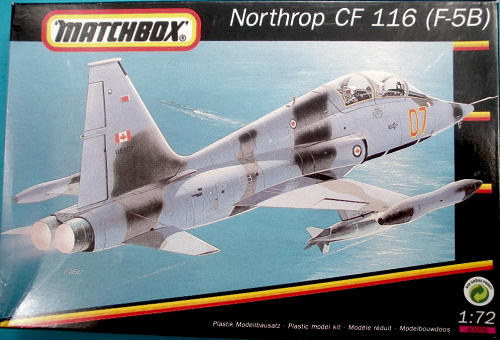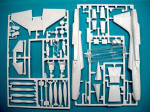Matchbox 1/72 CF-116D/F-5B Freedom Fighter
|
KIT #: |
PK-39 (1986) |
|
PRICE: |
$Currently OOP |
|
DECALS: |
Two Options |
|
REVIEWER: |
Victor
Scheuerman |
|
NOTES: |
This is the 1991 Revell boxing with better decals and single color molding |

The ‘Freedom
Fighter’ was the outcome of a 1954 decision by Northrop to produce a cheaper
lightweight fighter that could challenge the performance of more expensive
rivals. The end result, the F-5 (A single seat, B two-seat) was initially
exported as Mutual Aid Program equipment to
Greece,
Turkey,
Nationalist
China,
Philippines,
Iran
and
South Korea.
The
F-5B was also widely exported with examples being used by
Botswana,
Brazil,
Canada,
Ethiopia,
Jordan,
Libya,
Malaysia,
Morocco,
Netherlands,
Norway,
Saudi
Arabia,
Spain,
Thailand,
South
Vietnam
and
Venezuela.
Both the F-5A and F-5B would also be produced under license in both
Canada
and
Spain.
Northrop’s
initial models used two General Electric J85-GE-13 turbojets that would result
in a maximum speed of 925 M.P.H. at 36,000 feet. Though the F-5B was a trainer,
it could carry the full external load of 6,200 pounds of ordinance like the
single seater, though it lacks the latter’s two 20 MM cannons. One of the
criticisms of this basic jet is its short range and because of this, it almost
always carries its signature ‘Coke-bottle’ wing-tip tanks.
 Matchbox’s
version of this widely exported trainer encompasses a total of 42 parts
including a clear one-piece canopy. The external surface is a combination of
both raised (petit) and engraved panel lines with the latter not quite their
normal ‘trench’ depths. A very basic cockpit is offered with two almost adequate
ejections seats and the rear instrument panel console.
Matchbox’s
version of this widely exported trainer encompasses a total of 42 parts
including a clear one-piece canopy. The external surface is a combination of
both raised (petit) and engraved panel lines with the latter not quite their
normal ‘trench’ depths. A very basic cockpit is offered with two almost adequate
ejections seats and the rear instrument panel console.
External
stores include two bombs for the underwing pylons and the option of Sidewinders
(poor interpretations) or the fuel tanks (nicely captures their unique shape)
for the wing tips. Matchbox did a good job on the landing gear with the main
struts having their almost scale retraction arms molded in place and the wheels
feature some detail. However, as normal, the gear doors are rather thick and
should be replaced with card or sanded thinner.

As this is a Revell boxing
the nine assembly steps are well illustrated with detail colours notes offered
at each step. In addition, the two decal options are very well covered with each
having four views showing the camouflage pattern (Canadian) and decal locations.
Again, because this
is a Revell boxing the decals are quite nice for both options.
A
Canadian “Aggressor” is the first option and Red 02 (box art shows Red
07!) and this features a wrap around scheme that requires mixing both of the
recommend colours. I would question this scheme as it may be the Faux Pas II
Scheme of Grey 36473 and Blue 35550 that was only carried by Red 06.
This aircraft also features the small size national insignia.
A Norwegian is the second option, but I would also question the recommend
over all white finish (should be sprayed aluminum?). In addition to full size
national insignia, it features the unit emblem on the tail. Basic stencils are
provided for both aircraft and the false canopy for the bottom of the aggressor
is also included.
While the ESCI/Italeri
is a much better two seat F-5 in this scale, the Matchbox kit does come out
ahead of the Hasegawa and Pioneer alternatives.
If you would like your product reviewed fairly and quickly, please
contact
me or see other details in the
Note to
Contributors.
Back to the Main Page
Back to the Previews Index Page


 Matchbox’s
version of this widely exported trainer encompasses a total of 42 parts
including a clear one-piece canopy. The external surface is a combination of
both raised (petit) and engraved panel lines with the latter not quite their
normal ‘trench’ depths. A very basic cockpit is offered with two almost adequate
ejections seats and the rear instrument panel console.
Matchbox’s
version of this widely exported trainer encompasses a total of 42 parts
including a clear one-piece canopy. The external surface is a combination of
both raised (petit) and engraved panel lines with the latter not quite their
normal ‘trench’ depths. A very basic cockpit is offered with two almost adequate
ejections seats and the rear instrument panel console.